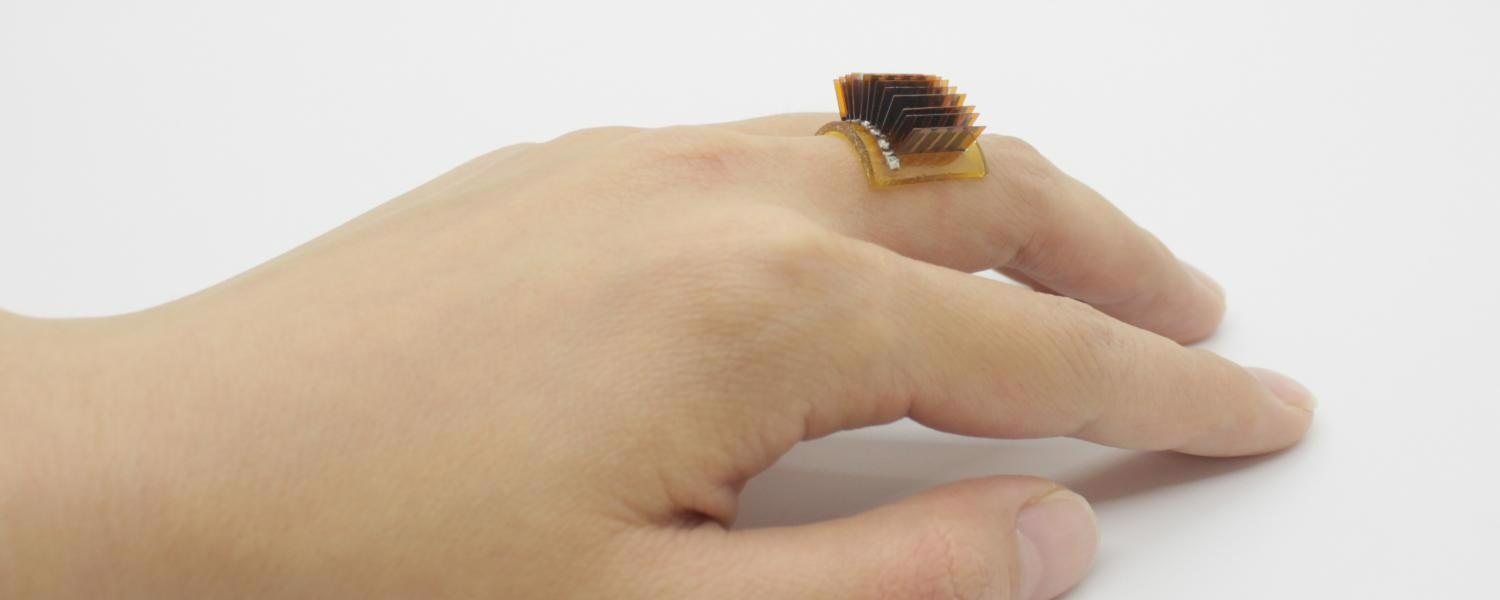Feb 12 2021
Scientists from the University of Colorado Boulder have designed a novel, affordable wearable device that turns the human body into a biological battery.
 A thermoelectric wearable device worn as a ring. Image Credit: Xiao Lab.
A thermoelectric wearable device worn as a ring. Image Credit: Xiao Lab.
Described recently in the Science Advances journal, the device is so flexible that it can be worn like a bracelet, ring, or any other accessory that makes contact with the skin. The device also taps into an individual’s natural heat—using thermoelectric generators to turn the internal temperature of the human into electricity.
In the future, we want to be able to power your wearable electronics without having to include a battery.
Jianliang Xiao, Study Senior Author and Associate Professor in Paul M. Rady Department of Mechanical Engineering at CU Boulder
The researchers' new devices can produce around 1 V of energy for each square centimeter of skin space—that is, less voltage for each area than that provided by most present-day batteries but still sufficient to power electronics, such as fitness trackers or watches.
While similar thermoelectric wearable devices have already been tested by scientists, Xiao’s device is flexible, can heal on its own when impaired, and is fully recyclable—rendering it a cleaner alternative to conventional electronics.
Whenever you use a battery, you’re depleting that battery and will, eventually, need to replace it. The nice thing about our thermoelectric device is that you can wear it, and it provides you with constant power.
Jianliang Xiao, Study Senior Author and Associate Professor in Paul M. Rady Department of Mechanical Engineering at CU Boulder
High-Tech Bling
The new study is not the first attempt of Xiao to combine humans with robots. Along with his collaborators, Xiao has previously attempted to develop “electronic skin”—wearable devices that both look and behave almost like the real skin of humans. But that android epidermis could work only when it is linked to an external power source.
Now, the latest innovation of the team starts with a base created from a flexible material, known as polyimine. A range of thin thermoelectric chips is then stuck into that base, linking them all with liquid metal wires. The resultant product appears like a cross between a tiny computer motherboard and a plastic bracelet, or perhaps a techy diamond ring.
Our design makes the whole system stretchable without introducing much strain to the thermoelectric material, which can be really brittle.
Jianliang Xiao, Study Senior Author and Associate Professor in Paul M. Rady Department of Mechanical Engineering at CU Boulder
Imagine people going out for a jog. While exercising, their body would heat up and this heat will radiate out to cool the atmosphere around them. The new device developed by Xiao captures that flow of energy instead of allowing it to go to waste.
“The thermoelectric generators are in close contact with the human body, and they can use the heat that would normally be dissipated into the environment,” Xiao added.
Lego Blocks
According to Xiao, that power can be easily increased by introducing additional blocks of generators. In that context, Xiao compares his new design to a popular kids’ toy.
“What I can do is combine these smaller units to get a bigger unit,” he said. “It’s like putting together a bunch of small Lego pieces to make a large structure. It gives you a lot of options for customization,” Xiao added.
For instance, Xiao and his collaborators estimated that an individual taking a brisk walk could utilize a device resembling a standard sports wristband to produce around 5 V of electricity—which is more than the electricity generated by the majority of the watch batteries.
Similar to Xiao’s electronic skin, the novel devices are equally resilient as biological tissues. For instance, if a device tears, the broken ends can be pinched together, and these can be sealed back up in a matter of minutes. And after the device is fixed, it can be immersed into a unique solution that will remove the electronic parts and dissolve the polyimine base—all those ingredients can then be utilized again.
“We’re trying to make our devices as cheap and reliable as possible, while also having as close to zero impact on the environment as possible,” Xiao concluded.
Although certain issues still need to be worked out in the new design, Xiao believes that his team’s devices would reach the market in the next 5 to 10 years.
Coauthors of the new article include scientists from China’s Harbin Institute of Technology, Southeast University, Zhejiang University, Tongji University, and Huazhong University of Science and Technology.
New wearable device turns the body into a battery
Video Credit: University of Colorado at Boulder.
Journal Reference:
Ren, W., et al. (2021) High-performance wearable thermoelectric generator with self-healing, recycling, and Lego-like reconfiguring capabilities. Science Advances. doi.org/10.1126/sciadv.abe0586.